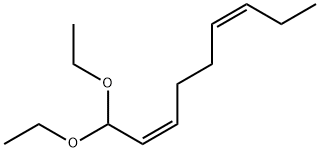Chemical Properties
Nona-2-trans-6-cis-dienal is a clear colorless to pale yellow liquid that has an odor reminiscent of green cucumber. The organoleptic character of this compound is attributed almost entirely to olfactory sensations. May be obtained from the steam distillation of fresh cucumber.
Occurrence
Reported as naturally occurring in violet leaves and flowers, in cucumber, sweet and sour cherry, guava, peas,
tomato, potato, bell pepper, wheat bread, rye bread, milk, milk powder, fish and fish oil, roast chicken, guinea hen, beef, beer, coffee,
tea, oats, mango, kelp, prickly pear, malt, dried bonito, endive, oysters, clam and mate.
Uses
trans-2,cis-6-Nonadienal is an unsaturated aldehyde that is responsible for the cucumber smell of Synura petersenii, a freshwater colonial flagellate. trans-2,cis-6-Nonadienal is also a common natural and drinking water contaminant.
Preparation
From natural hexenol
Definition
ChEBI: (2E,6Z)-nona-2,6-dienal is an enal that is (2E,6Z)-nona-2,6-diene substituted by an oxo group at position 1. It has a role as a plant metabolite. It is an enal and a trans-2,3-unsaturated fatty aldehyde.
Aroma threshold values
Detection: 0.01 ppb
Taste threshold values
Taste characteristics at 10 ppm: green, melon, cucumber-like with an aldehydic nuance
Synthesis Reference(s)
The Journal of Organic Chemistry, 38, p. 36, 1973
DOI: 10.1021/jo00941a008
General Description
trans-2,cis-6-Nonadienal is the key contributor to the cucumber flavor. It is also found in mango ripened anchovy and kelp. Unialgal cultures of various Synurophycean species for the occurrence of trans-2,cis-6-nonadienal have been investigated.
Safety Profile
Low toxicity by
ingestion and skin contact. A moderate skin
irritant. When heated to decomposition it
emits acrid smoke and irritating fumes.





